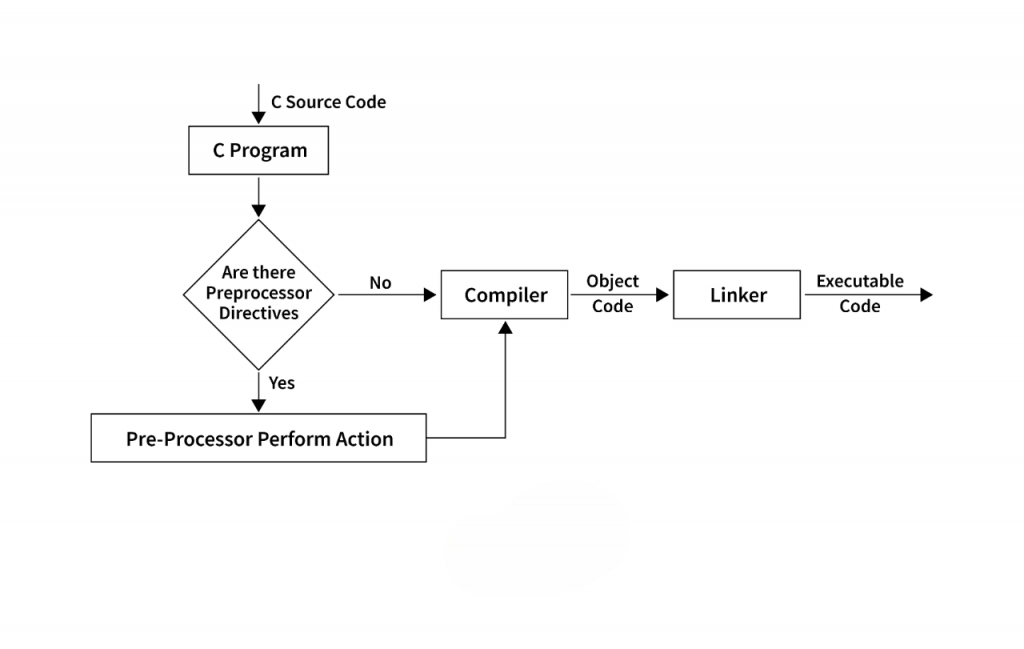
- What are Preprocessor Directives?
- Role of Preprocessor in C Compilation
- #define and Constants
- #include Directive
- Conditional Compilation (#if, #ifdef, #ifndef)
- #undef and Redefinition
- Macros with Arguments
- Conclusion
What are Preprocessor Directives?
In the C programming language, preprocessor directives are instructions processed by the preprocessor before the actual compilation of code begins. These directives begin with the # symbol and are used for including files, defining constants and macros, and conditional compilation. The preprocessor performs text substitution and conditional inclusion, helping programmers manage complex codebases efficiently. They do not end with a semicolon and are executed before the compiler starts translating the code into machine language.Preprocessor directives are special instructions in programming languages like C and C++ that are processed before the actual compilation of the code begins. They start with a hash symbol (#) and provide commands to the compiler’s preprocessor, which performs tasks such as file inclusion, macro substitution Web Designing Training, and conditional compilation. Common preprocessor directives include #include, #define, #ifdef, #ifndef, #else, and #endif.
The #include directive is used to include the contents of a file or library into the current source file, allowing code reuse and modular programming. For example, #include
To Earn Your Web Developer Certification, Gain Insights From Leading Data Science Experts And Advance Your Career With ACTE’s Web Developer Courses Today!
Role of Preprocessor in C Compilation
- File Inclusion: Handles #include directives by inserting the contents of header files into the source code.
- Macro Expansion: Replaces macros defined with #define throughout the code with their corresponding values or expressions.
- Conditional Compilation: Processes directives like #ifdef, #finder, #if, #else, and #endif to compile code selectively based on defined conditions Backend Development .
- Removing Comments: Strips out all comments from the source code before compilation.
- Line Control: Keeps track of line numbers and file names for accurate error reporting using #line.
- Generating Intermediate Code: Produces an expanded source code file (often called the translation unit) that is passed on to the compiler for actual compilation.

#define and Constants
- #define Directive: The #define directive is a preprocessor command used to create macros or symbolic constants. It tells the preprocessor to replace every occurrence of a specified identifier with a defined value or expression before compilation. For example, #define PI 3.14 replaces all instances of PI in the code with 3.14. Unlike variables, macros do not consume memory and are replaced literally in the code. However, IT Engineer Salary in India #define does not have a type, so it lacks type safety.
- Constants: Constants in C are fixed values that cannot be changed during program execution. They can be defined using the const keyword, like const float pi = 3.14;, which creates a typed constant variable that the compiler enforces as immutable. Unlike macros, constants provide type safety and scope control, making them safer and often preferred in modern C programming.
- #include
- #include “myfile.h” // User-defined file
- Angle brackets (<>): For standard system header files
- Double quotes (“”): For user-defined header files in the working directory
Would You Like to Know More About Web Developer? Sign Up For Our Web Developer Courses Now!
#include Directive
#include` is a preprocessor directive used to include the contents of one file into another during compilation.
It is commonly used to include standard or user-defined header files
Web Designing Training.
There are two forms: `#include
Syntax:
Types of Inclusion:
Conditional Compilation (#if, #ifdef, #ifndef)
Best Software Development Courses These directives allow sections of code to be compiled only if certain conditions are met.
#if and #else:
- #if DEBUG
- printf(“Debug mode on\n”);
- #else
- printf(“Release mode\n”);
- #endif
#ifdef (if defined):
- #ifdef FEATURE_X // Code for FEATURE_X
- #endif

#ifndef (if not defined):
- #ifndef HEADER_H
- #define HEADER_H // Header file content
- #endif
This is commonly used to prevent multiple inclusions of the same header file.
Are You Interested in Learning More About Web Developer? Sign Up For Our Web Developer Courses Today!
#undef and Redefinition
In C programming, the #undef preprocessor directive is used to undefine or remove a macro that was previously defined using #define. This directive is particularly useful when you need to change the value or behavior of a macro within the same source file or when you want to prevent a macro from affecting subsequent code. By using #undef, you tell the preprocessor to forget the existing definition of the macro, allowing you to safely redefine it later without causing conflicts. Redefining a macro without first undefining it can lead to warnings or errors during compilation. Most C compilers detect when a macro is redefined with a different value or replacement list and generate a warning Become an IT Engineer, as this can cause ambiguity or unexpected behavior in the code. For example, if you have:- #define SIZE 10
- #define SIZE 20
Many compilers will warn that SIZE is being redefined. This is because the preprocessor replaces every occurrence of SIZE with its defined value, and changing that definition mid-way can lead to inconsistent results. To avoid such issues, you should use #undef before redefining:
- #define SIZE 10
- #undef SIZE
- #define SIZE 20
Here, the #undef SIZE ensures that the previous definition is removed, and the new definition takes effect cleanly. Another important use case for #undef is in conditional compilation scenarios, where a macro might be defined in some contexts but needs to be undefined in others. This control over macro definitions enhances code flexibility and maintainability, especially in large projects with multiple source files and complex build configurations. In summary, #undef provides a way to explicitly remove a macro definition, preventing accidental redefinition errors and giving programmers control over when and how macros are defined or redefined. Proper use of #undef ensures cleaner, more predictable preprocessing and compilation of C programs.
Macros with Arguments
Macros with arguments in C are a powerful feature of the preprocessor that allow you to define parameterized macros, similar to functions but handled entirely at compile-time through textual substitution. Unlike simple macros that replace a name with a fixed value or expression, macros with arguments can take one or more parameters and generate code dynamically based on those parameters. The syntax involves defining a macro using #define followed by the macro name and a list of parameters in parentheses. For example, #define SQUARE(x) ((x) * (x)) defines a macro that computes the square of its argument. When the preprocessor encounters a macro with arguments in the code, it replaces it with the corresponding expression, substituting the provided arguments directly into the macro body. This enables writing reusable Complete Guide on System Software, inline code snippets that can improve performance by avoiding function call overhead. However, macros have no type checking and can sometimes lead to unexpected results due to operator precedence or side effects if arguments involve expressions with increment operators or function calls. To avoid such issues, it is common to enclose macro parameters and the entire macro body in parentheses. While macros with arguments are useful for simple inline calculations and code reuse, modern C programming often favors inline functions for better type safety and debugging support. Nevertheless, understanding macros with arguments remains important for working with legacy code and low-level programming.
Conclusion
Preprocessor directives play a critical role in controlling the compilation process in C. They are simple yet powerful tools for file inclusion, macro creation, and conditional logic. Mastering these helps in writing cleaner, more maintainable, and portable code. As your programs grow in size and complexity, proper use of preprocessor directives can significantly enhance your productivity and project organization.In conclusion, both #define and constants are essential tools for representing fixed values in C programming Web Designing Training. While #define offers simple and efficient textual substitution without memory usage, it lacks type safety and scope control. On the other hand, constants declared with the const keyword provide type safety, better debugging support, and are generally preferred for maintaining readable and reliable code. Understanding when and how to use each effectively helps create clean, maintainable, and efficient programs.



